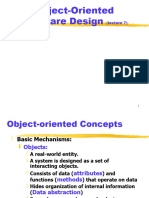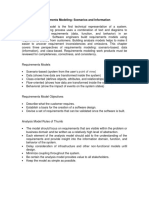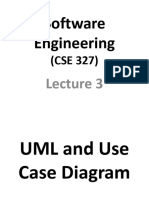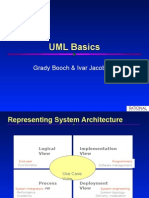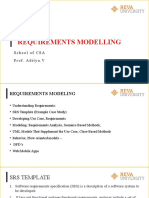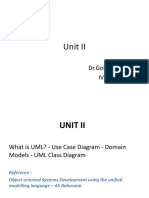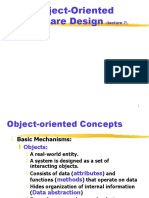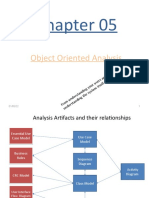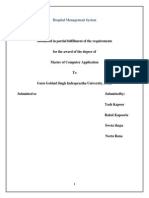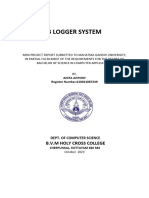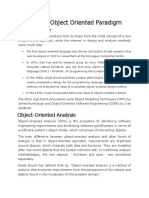Modeling
ECE 417/617: Elements of Software Engineering
Stan Birchfield Clemson University
Overview
Modeling provides abstraction to bridge the gap between
High-level (world) Low-level (code)
Types of modeling:
Analysis modeling
Models problem domain (users, world)
System modeling
Models solution domain (software)
Analysis modeling
Let us first look at modeling the problem domain
Requirements elicitation
It is important to define what the software is supposed to do before
defining how to do it, or before actually doing it
The hardest single part of building a software system is deciding what to build. Fred Brooks Requirements elicitation gathering requirements from users and other stakeholders
Difficulties in specifying requirements
Customers often do not know what they want ... until they see it Customers often have a poor understanding of the ease or difficulty of implementing different capabilities The requirements change over time
Steps in gathering requirements
Inception establish basic understanding of problem Elicitation Ask the users what is needed Elaboration Refine the model of the S/W functions, features, and constraints Negotiation Reconcile conflicts by ranking requirements and discussing priorities Specification Final work product describing the function and performance of the S/W Validation Examine the specification to ensure that all requirements have been stated unambiguously, inconsistencies have been corrected, etc.
Specifying requirements
Requirements can be specified in a number of ways:
user scenarios functions and feature lists analysis models specification
Traceability table
Captures the relationships between
features and requirements interfaces and requirements requirements themselves (dependencies) aspects etc.
A01 A02 A03 ... R01
requirements
R02
R03 ...
User scenarios
Usage scenarios
identify a thread of usage for the system enable the S/W team to see how the functions and features will be used by different classes of end users often called use cases
Use cases
Use case tells a stylized story about how an enduser interacts with the system under a specific set of circumstances Can be either
narrative text outline of tasks or interactions template-based description, or diagrammatic representation
A use-case captures a contract... -- Alistair Cockburn, Writing Effective Use Cases. AddisonWesley 2000. http://www.usecases.org/
Use case example
Use case: Withdraw money
Level: User goal Primary actor: Client Goal in context: To withdraw money from the clients account Preconditions: User has an account, ATM has power and connectivity Main scenario: 1. Client inserts card 2. Client types PIN 3. Client specifies which account 4. Client enters amount to withdraw 5. Money is dispensed 6. Card is ejected 7. Client removes card Extensions: 1a. Card is invalid; card is ejected and client notified. 2a. Pin is incorrect; client notified and given no more than two more attempts. 4a. Amount exceeds limit; client notified, repeat step. 7a. Client does not remove card within time limit; card is retracted. (Three levels: Summary, User goal, and Sub-function level)
System modeling
Now let us look at modeling the solution domain
Data flow diagram (DFD)
Data flow diagram (DFD) developed in late 1970s
part of Structured Design (one of the earliest methodologies for software development); aka Structured Systems Analysis and Design Method (SSADM), a waterfall method invented by Larry Constantine, who also developed concepts of coupling and cohesion
DFD is a forerunner of UML and may complement it Arcs are data; boxes are processes/actions
source code test plan execute unit tests test results review test results review decision
Gane and Sarson notation for DFDs
squares external entities round rectangles processes arrows data flow open-ended rectangles data stores
http://www.agilemodeling.com/artifacts/dataFlowDiagram.htm
Data flow diagram (DFD)
DFDs are refined iteratively
Level 0 is context-level DFD; represents s/w as a single bubble with input and output Level 1 is achieved by expanding the bubble into additional bubbles; perform grammatical parse on narrative describing bubble Continue refining until each bubble performs specific function; high cohesion Components: bubbles are processes, boxes are external entities, arrows are data or control objects, and double lines are data stores
Process specification (PSPEC) describes all flow model processes that appear at the final level of refinement. It is a minispec for each transform at the lowest level of a DFD Program design language description (PDL) is basically pseudocode. One way to represent PSPEC
CRC modeling
Class Responsibility Collaborator (CRC) is a lightweight model
Write on 3x5 index cards Used in extreme programming Can be used for
detailed object-oriented design conceptual modeling
http://www.agilemodeling.com/artifacts/crcModel.htm
CRC example
class is collection of objects
two types of collaboration: request for information request to do something
responsibility is anything a class knows or does
http://www.agilemodeling.com/artifacts/crcModel.htm
Creating CRC cards
Iteratively Find classes Find responsibilities Define collaborators Move the cards around
http://www.agilemodeling.com/artifacts/crcModel.htm
Unified modeling language (UML)
Several competing object-oriented notations developed in 1980s and 1990s Rumbaugh and Booch began working together in 1994 at IBM Rational to standardize their notations (OMT and Booch) Result was Unified Modeling Language (UML) Rights owned by Object Management Group (OMG), www.omg.org Good reference: M. Blaha and J. Rumbaugh, Object-Oriented Modeling and Design with UML, 2nd ed.
UML
Unified modeling language (UML) includes three models: class model structural aspects of system (class diagrams) state model temporal, behavioral aspects of system (state diagrams) interaction model collaboration of individual objects (use cases, sequence diagrams, and activity diagrams)
A simple problem to provide brief overview of UML
switch
1W
5V
light
1. Use Case Diagram
SimpleCircuit FlipOn FlipOff ViewLight User Functionality from users point of view
2. Class Diagram
Switch
Resistor Battery 5V
Light
Structure of system (objects, attributes, associations, operations)
3. Sequence Diagram
User
Switch
Resistor
Battery
Light
FlipOn()
HeatUp()
Drain()
Shine()
Messages between objects
3. Collaboration Diagram
User
1. FlipOn()
Switch
1.2 Shine()
1.1 HeatUp()
Resistor
1.3 Drain()
Light
Battery
More compact, but harder to interpret
4. Statechart Diagram
flipSwitchOn Light Off Light On
flipSwitchOff
Transitions between states of one object (Extension of Finite State Machine (FSM) model)
4. Statechart Diagram (different objects)
flipSwitchOn
flipSwitchOn
Not Draining
Cold
Hot
Draining
flipSwitchOff
flipSwitchOff (Battery)
(Resistor)
5. Activity Diagram
Flip Switch On With swimlanes:
Actor1 Actor2
Flip Switch Off
Flip Switch On
Read Book
Actions are states
Summary
We have looked at five UML diagrams: 1. Use case diagrams [Interaction Model]
-- models functionality from users point of view
2. Class diagrams
-- models structure of system using objects
[Class Model] [Interaction Model]
3. Interaction diagrams
(sequence and collaboration) -- models messages passed between objects
4. Statechart diagrams
-- models transitions between states
[State Model]
5. Activity diagrams
[Interaction Model] -- models flow control as transitions between activities
The actual UML spec has 12 diagrams, but these five will be sufficient for us.





